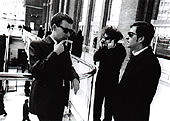 Pullman Pullman
"Turnstyles & Junkpiles"
(Thrill Jockey)
Members of Pullman share the common belief that "instrumental music can be lyrical." Their debut album, "Turnstyles & Junkpiles," was recorded live in the "Cool Blue Cave" (i.e. Bundy Brown's Chicago loft) in four days. The only equipment on hand was an analog two-track, a pair of AKG 451-EB microphones, and four fertile-minded musicians.
To understand the Pullman theory, you should know who they are. Members of Chicago's inner circle of "post-rock" naturalists--Bundy K. Brown of Directions in Music, Curtis Harvey of Rex, Chris Brokaw of Come, and Douglas McCombs of Tortoise. They've all been friends and collaborators for years, and finally got together to form their own acoustic, four-guy, kitchen jam band.
To understand the Pullman sound takes time, contemplation, and insight. The underlying aesthetic of acoustic guitar and bass, enhanced by stringed cousins such as the mandola, dobro, and banjo, make "Turnstyles and Junkpiles" a kind of transcendental detoxification process. Listening to the album, you start considering the options...Buddhism, veganism, a world without color lines. But the music is deceptive in its mellow, at times opaque, charm. The layers of pauses and half-steps reflect a buried treasure beneath the surface.
To its credit, "Turnstyles & Junkpiles" is hard to compare to other current records. There are hints of Nusrat Fateh Ali Khan atmospheres, Ben Harper fingerstyles, and an all-around nod to John Fahey. Despite the fact that writing the album was an exercise in horizontal creativity, there is a specific, almost individualistic, continuity. The 14 tracks almost feel like a well-thought-out collage, though "Gravenhurst" nudges its head above the water with its catchy organic melody. "Lyasnya" is a terse little character-driven ballad, with counter-melodies that sound like untreated guitars flirting with tango riffs.
There's something reassuring about the union of good, subtle musicians who've spent nearly five years preparing to get together and make great music. Individual talent aside, all signs indicate Pullman may be close to understanding the collective theory.
--Anicee Gaddis
 Jesus and Mary Chain Jesus and Mary Chain
"Munki"
(Subpop)
Where do you go after you create a new sound? The Jesus and Mary Chain have tried to answer that question since their first record, the legendary "Psychocandy," which blended punk feedback 'n' howl with the melodic wistfulness of '60s girl groups. It made noise popular and encouraging hundreds, if not thousands, of kids with no musical talent to pick up cheap guitars and secondhand fuzzboxes and go to it.
The eternally brawling Reid brothers themselves have attempted to move beyond their big first act, going somber and acoustic ("Darklands"), bombastic and glitter-pop ("Automatic"), and hitting many of the points in between. "Munki" attempts to combine all of it into what can be best described as an album that celebrates all the albums, everyone's albums, that came before. That case is stated clearly in the opener, "I Love Rock 'n' Roll," which preaches the mindless joy of being a rock star in big-dumb-guitar fashion, replete with Yes-style synths lurking in the background and a horn section marching across the front lines. Besides, it's kind of a treat to hear the usually forlorn and pessimistic Jim Reid singing "I love what I'm doing" in absolute earnest. The follow-up, "Birthday," complies old JAMC feedback fashions: like a painter can tell the difference between Aegean and cerulean blue, so the Reid brothers can tell Fulltone woof from MXR whoosh. Here it's all orchestrated: the minimal fuzz bass 'n' drum machine drops behind the choppy, static-y strumming, which is submerged in a spiky, high-voltage wall of feedback before a perfect shimmer of tingling, tambourine-laced guitar envelops it in the chorus.
"Perfume" nods to the current female rocktronica fashion in a minimal collage of strings, breakbeats, and prolonged guitar chords with a guest appearance by Mazzy Star vocalist Hope Sandoval. Looking backward is "Cracking Up," a dark, rhythm-heavy, '80s-style tune--though not the JAMC '80s, more like the Killing Joke Reagan decade. The catchiest number is probably "Supertramp," with its rapid-fire drumming and excessive maracas driving the rise and fall of high-pitched backing vocals over wailing fuzz. "Munki" closes, naturally, with "I Hate Rock 'n' Roll," a grittier, messier, cacophony (typically Jesus and Mary Chain) based on the opener, in which William curses everything Jim praised: "I hate rock 'n' roll and all these people with nowhere to go."
What prevents "Munki" from fulfilling its potential is its length--there's 17 songs in 70 minutes, and most of them are at least four minutes long--a few could've been cut down or cut out and strengthened the remainder. But this a persistent problem in the CD era: musicians feel obliged to fill up the damn things. Still, when the Jesus and Mary Chain get it right, it is very right, and you're fully prepared to believe that BB King is our savior, Mo Tucker sits at his right hand, and the wah-wah pedal rules above all.--Lissa Townsend Rodgers
Send feedback here.
|

